Recently published English language booksThere are all the English language books found in the system that have been published from 2000 to this day. If you think we are missing some please let us know. | | by Aaron Stephan Hamilton
The naval archaeology of a U-boat
2019, Osprey Publishing
ISBN 1472835816
Hardcover, 128 pages
A detailed study of history and marine archaeology of an innovative late-World War II U-boat that currently lies as a wreck in the Potomac River.Now in its final resting place at the bottom of the Potomac River in Maryland, the U-Boat U-1105 is unique among German World War II submarines. Technologically innovative, it was the only U-Boat to conduct a wartime patrol while equipped with the snorkel, GHG Balkon passive sonar and a rubberized coating known as Alberich designed to reduce its acoustic signature and hide from Allied sonar. After the end of World War II, it was the subject of instense testing and evaluation by the Allies, before finally being sunk to the bottom of the Potomac River.This highly illustrated book uses many new and previously unpublished images to tell the full story of this remarkable U-Boat, evaluating the effectiveness of its late war technologies, document its extensive postwar testing and detail all the features still present on the wreck site today.Purchase information: (info)
 Get German submarine U-1105 'Black Panther' now at amazon.co.uk (£ 20.00) Get German submarine U-1105 'Black Panther' now at amazon.co.uk (£ 20.00) |
 | by Platon Alexiades
2015, Pen and Sword
ISBN 1473827566
Hardcover, 288 pages
During the Second World War the Corinth Canal assumed an importance disproportionate to its size. It was the focus of numerous special Allied operations to prevent oil from the Black Sea reaching Italy, to delay the invasion of Crete and severing the vital German supply lines to Rommel’s Army in North Africa.German airborne forces occupied the Canal to cut off the ANZAC retreat and Hitler needed the Canal kept open to maintain control of the Aegean Sea. Were this lost, he feared Turkey entering the War on the Allied side.Target Corinth Canal unearths a treasure trove of facts on the little known operations by SOE and other special force units. Heroes such as Mike Cumberlege emerge from the pages of this splendid work of military history. |
 | by William Geroux
Seven Brothers and the War Against Hitler's U-boats
2017, Penguin Books
ISBN 014310926X
Paperback, 400 pages
“Vividly drawn and emotionally gripping."—Daniel James Brown, #1 New York Times bestselling author of The Boys in the Boat. One of the last unheralded heroic stories of World War II: the U-boat assault off the American coast against the men of the U.S. Merchant Marine who were supplying the European war, and one community’s monumental contribution to that effort Mathews County, Virginia, is a remote outpost on the Chesapeake Bay with little to offer except unspoiled scenery—but it sent an unusually large concentration of sea captains to fight in World War II. The Mathews Men tells that heroic story through the experiences of one extraordinary family whose seven sons (and their neighbors), U.S. merchant mariners all, suddenly found themselves squarely in the cross-hairs of the U-boats bearing down on the coastal United States in 1942.
From the late 1930s to 1945, virtually all the fuel, food and munitions that sustained the Allies in Europe traveled not via the Navy but in merchant ships. After Pearl Harbor, those unprotected ships instantly became the U-boats’ prime targets. And they were easy targets—the Navy lacked the inclination or resources to defend them until the beginning of 1943. Hitler was determined that his U-boats should sink every American ship they could find, sometimes within sight of tourist beaches, and to kill as many mariners as possible, in order to frighten their shipmates into staying ashore.
As the war progressed, men from Mathews sailed the North and South Atlantic, the Caribbean, the Gulf of Mexico, the Mediterranean, the Indian Ocean, and even the icy Barents Sea in the Arctic Circle, where they braved the dreaded Murmansk Run. Through their experiences we have eyewitnesses to every danger zone, in every kind of ship. Some died horrific deaths. Others fought to survive torpedo explosions, flaming oil slicks, storms, shark attacks, mine blasts, and harrowing lifeboat odysseys—only to ship out again on the next boat as soon as they'd returned to safety.
The Mathews Men shows us the war far beyond traditional battlefields—often the U.S. merchant mariners’ life-and-death struggles took place just off the U.S. coast—but also takes us to the landing beaches at D-Day and to the Pacific. “When final victory is ours,” General Dwight D. Eisenhower had predicted, “there is no organization that will share its credit more deservedly than the Merchant Marine.” Here, finally, is the heroic story of those merchant seamen, recast as the human story of the men from Mathews.From the Hardcover edition. Purchase information: (info)
 Get The Mathews Men now at amazon.co.uk (£ 12.99) Get The Mathews Men now at amazon.co.uk (£ 12.99) |
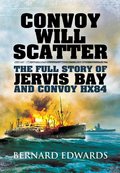 | by Bernard Edwards
The Full Story of Jervis Bay and Convoy HX84
2013, Pen and Sword
ISBN 1781593760
Hardcover, 224 pages
On 5 November 1940 the eastbound convoy HX 84 of thirty-seven merchant ships, escorted by the armed merchant cruiser HMS Jervis Bay was attacked in mid-Atlantic by the German pocket battleship Admiral Scheer. The Jervis Bay, commanded by Captain Edward Fegen, charged at the enemy. Hopelessly outgunned, she was blown out of the water by the Scheer’s 11-inch guns.Meanwhile, led by HX 84’s commodore ship, the Cardiff tramp Cornish City, the merchantmen scattered under the cover of a smoke screen, were picked off one by one by the radar-equipped Admiral Scheer.Captain Hugh Pettigrew, commanding the highly armed Canadian Pacific cargo liner Beaverford, began a desperate game of hide and seek with the Scheer, which continued until Beaverford was sunk with no survivors. Thanks to this sacrifice, incredibly, only four other merchantmen were sunk.Later the neutral flag Swedish freighter Stureholm, commanded by Captain Olander, picked up survivors from the Jervis Bay. Without this brave and dangerous gesture no one would have lived to tell the tale of the death throes of the Jervis Bay, whose Captain was awarded the VC.Sadly, the history books only mention the Beaverford and the Stureholm in passing. This thrilling book puts the record straight.Purchase information: (info)
 Get Convoy Will Scatter now at amazon.co.uk (£ 17.99) Get Convoy Will Scatter now at amazon.co.uk (£ 17.99) |
 | by Michael G. Walling
The Arctic Convoys of World War II (General Military)
2012, Osprey Publishing
ISBN 1849087180
Hardcover, 292 pages
Hitler called Norway the “Zone of Destiny” for Nazi Germany because convoys from Churchill's Britain and Roosevelt's United States supplied Stalin's Soviet Russia with critical equipment and foodstuffs during the darkest days of the German invasion. The words "Murmansk Run" conjure visions of ice-laden ships and thoughts of freezing to death in seconds. For five long years, thousands of men and women fought ferociously in the coldest corner of hell on earth. Some fought for survival, some struggled to help others survive, and some sought to crush their enemies. If man-made death didn't get you, the Arctic's weapons of ice and cold would. These natural weapons killed regardless of whose side you were on or how just was your cause. No one escaped unscathed. Author Mike Walling captures the Arctic convoys' bitter essence in Forgotten Sacrifice. The story launches in October 1939, when Germany and the Soviet Union began diplomatic maneuvering. The action accelerates with Winston Churchill's decision in 1941 to provide supplies to Soviet forces battling the German invasion. From this point until the closing days of WWII in spring 1945, an unremitting sea battle raged within the confines of the always-lethal, ever-shifting Arctic ice pack and the savage Scandinavian coastline. Nearly 4.5 million tons of supplies were moved in 77 convoys over the course of 5 years in order to help the Soviet war effort. The Allies fought to keep the sea lanes open to Murmansk while the Germans were determined to slaughter every ship which dared to make the attempt. By the end of the convoys, 98 ships had been lost. Forgotten Sacrifice reveals a timeless tale of determination, heroism, sacrifice, and the strength of the human spirit. |
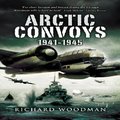 | by Richard Woodman
2007, Casemate Publishers
ISBN 1844156117
Paperback, 532 pages
During the last four years of the Second World War, the Western Allies secured Russian defenses against Germany by supplying vital food and arms. The plight of those in Murmansk and Archangel who benefited is now well known, but few are aware of the courage, determination and sacrifice of Allied merchant ships, which withstood unremitting U-boat attacks and aerial bombardment to maintain the lifeline to Russia. In the storms, fog and numbing cold of the Arctic, where the sinking of a 10,000 ton freighter was equal to a land battle in terms of destruction, the losses sustained were huge. Told from the perspective of their crews, this is the inspiring story of the long-suffering merchant ships without which Russia would almost certainly have fallen to Nazi Germany.Purchase information: (info)
 Get Arctic Convoys 1941 - 1945 now at amazon.co.uk (£ 20.00) Get Arctic Convoys 1941 - 1945 now at amazon.co.uk (£ 20.00) |
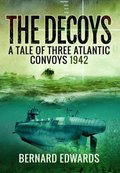 | by Bernard Edwards
A Tale of Three Atlantic Convoys 1942
2017, Naval Institute Press
ISBN 1473887089
Hardcover, 224 pages
In November 1942, Britain and America launched Operation TORCH, the ambitious invasion of French North African colonies of Morocco and Algeria. To convey 70,000 troops and their equipment required 350 merchant ships crossing the U-boat infested North Atlantic from the USA and 250 more sailing south from British ports. The need for a high level of protection for these meant withdrawing large numbers of escorts from the routine trade convoys. Amongst those left without adequate defence were RB 1 and SC 107, both eastbound from America, and SL 125, northbound from Freetown. All three were at sea at the same time as the TORCH convoys.Predictably, Admiral Donitz threw the full weight of his 140 Atlantic U-boat fleet against the now vulnerable trade convoys, which between them lost thirty-one ships and 792 men. While this unprecedented massacre was in progress, the troop-carrying convoys slipped miraculously through entirely without incident.There is nothing on record to say that RB 1, SC 107 and SL 125 were sacrificed to ensure the safe passage of the TORCH convoys but this superbly researched book sets out to examine the truth behind the rumors.Purchase information: (info)
 Get The Decoys now at amazon.co.uk (£ 33.50) Get The Decoys now at amazon.co.uk (£ 33.50) |
 | by David J. Bercuson
Hitler's War Against Caribbean Oil (Beyond Boundaries: Canadian Defense and)
2014, University of Calgary Press
ISBN 1552387593
Paperback, 368 pages
Long Night of the Tankers presents a fresh account of a lesser-known but critical component of the Atlantic naval theatre during World War II. Using war diaries, after-action reports, and first-hand accounts, authors Bercuson and Herwig examine the story behind Operation Neuland, the German plan to interrupt vital oil supplies from reaching the United States and the United Kingdom by preventing Allied oil tankers from leaving refineries in the Caribbean. The story begins in February 1942 and follows this German attempt to scuttle the Allied war machine through to the end of the war. Told largely from the German perspective, it details the planning and execution of the Germans and the diplomatic, political, and military responses of the Allies, particularly the United States, to overcome the German effort.Purchase information: (info)
 Get Long Night of the Tankers now at amazon.co.uk (£ 26.99) Get Long Night of the Tankers now at amazon.co.uk (£ 26.99) |
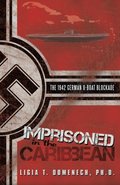 | by Ligia T. Domenech
The 1942 German U-boat Blockade
2014, iUniverse
ISBN 149175270X
Paperback, 224 pages
Winston Churchill recognized in his memoirs: "The only thing that ever really frightened me during the war was the U-boat peril" His fears would be realized in the Caribbean: By the end of the war, the Germans had sunk four hundred merchant ships in the Caribbean while only losing seventeen U-boats in what was called Operation Neuland. Begun in 1942, the campaign sought to cut the supply lines from the Caribbean to the Allies with the intention of strangling their import-based economies. Colonies of various empires would be left to fend for themselves. Dr. Ligia T. Domenech explores how the campaign hurt the people of the Caribbean, focusing on her native Puerto Rico. Learn about the principal targets of the German U-boats in the Caribbean, the United States' reaction to Operation Neuland, the shortage of essential goods, new industries that developed during the war period, and the blockade's long-lasting effects. To this day, the public and even most historians don't know about the blockade's devastating effects and what it meant to be Imprisoned in the Caribbean.Purchase information: (info)
 Get Imprisoned in the Caribbean now at amazon.co.uk (£ 12.95) Get Imprisoned in the Caribbean now at amazon.co.uk (£ 12.95) |
 | by Deborah Lake
Q-Ships against the U-Boats in the First World War
2009, The History Press
ISBN 0752450557
Paperback, 256 pages
The Q-ship, an ordinary merchant vessel with concealed guns, came into its own during World War I, when used by the Royal Navy to trap and destroy German U-boats. The Q-ship operations are covered here in detail, by following the careers of the eight men who won the Victoria Cross on Special Service Operations; and by accounts of German U-boat crews being on the receiving end. No book on Q-ships can avoid the Baralong incident in which a Q-ship's crew allegedly executed the survivors of the German submarine U-27, on August 19, 1915. In a subsequent encounter with U-41, more British atrocities were alleged by the only two German survivors. Revealing extracts from the diary of a Royal Marine who served on board the Baralong are reproduced here, together with other first-hand accounts. With charge and counter-charge, this incident provides a fascinating story. |
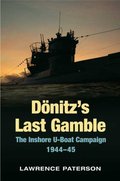 | by Lawrence Patterson
The Inshore U-Boat Campaign 1944-45
2008, Seaforth Publishing
ISBN 1844157148
Hardcover, 208 pages
By the end of 1943 the German submarine war on Atlantic convoys was all but defeated, beaten by superior technology, code-breaking and air power. With losses mounting, Dönitz withdrew the wolfpacks, but in a surprise change of strategy, following the D-Day landings in June 1944, he sent his U-boats into coastal waters, closer to home, where they could harass the crucial Allied supply lines to the new European bridgehead. Caught unawares, the British and American navies struggled to cope with a novel predicament -in shallow waters submarines could lie undetectable on the bottom, and given operational freedom, they rarely needed to make signals, so neutralizing the Allied advantages of decryption and radio direction-finding. Behind this unpleasant shock lay an even greater threat, of radically new sub- marine types known to be nearing service. Dönitz saw these as war-winning weapons, and gambled that his inshore campaign would hold up the Allied advance long enough to allow these faster and quieter boats to be deployed in large numbers. This offensive was perhaps Germany's last chance to turn the tide, yet, surprisingly, such an important story has never been told in detail before. That it did not succeed masks its full significance: the threat of quiet submarines, operating singly in shallow water, was never really mastered, and in the Cold War that followed the massive Soviet submarine fleet, built on captured German technology and tactical experience, became a very real menace to Western sea power. In this way, Dönitz's last gamble set the course of post-war anti submarine development.REVIEWS “…recommend highly to anyone interested in submarine warfare of WW2, and for anyone interested in understanding how that effected naval warfare into the 21st Century. …very high quality history.” IPMS, 11/2008Purchase information: (info)
 Get Donitz's Last Gamble now at amazon.co.uk (£ 25.00) Get Donitz's Last Gamble now at amazon.co.uk (£ 25.00) |
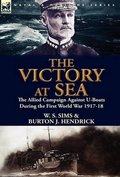 | by W. S. Sims
the Allied Campaign Against U-Boats During the First World War 1917-18
2012, LEONAUR
ISBN 1782820426
Hardcover, 340 pages
Victory snatched from imminent defeat This book by the American, Admiral Sims will be a revelation to many. The British public had no idea that by the time America entered the First World War on 6th April, 1917 the Allied cause was on the brink of falling to the might of Imperial Germany. No plan had been conceived to ensure that vital materials would reach Britain by sea without them falling prey to the omnipresent U-Boat menace. Thousands of tons of essential war supplies were going to the bottom of the Atlantic Ocean each week and serious Allied analysts believed that Britain would last less than four months before surrender was inevitable. Given what we now know of the great German land offensives of the final phase of the war, the consequences for the Allies, without a solution to the issue of maritime supply, could have been catastrophic. The solution came in the form of the creation of the convoy system and its effectiveness was due in no small part to the addition of the U. S. N. destroyer fleet to support the activities of the Royal Navy. This book describes how the German U-Boat threat was finally overcome and how this impacted on the Allied victory. Sims also gives much operational detail including the activities of the deadly decoy's, the 'Q' ships, and the operations of the 'King Cobras' of the undersea war-the anti-submarine submarines.' This is the view and account of a senior officer in a position to experience and describe for posterity the strategic and tactical issues of the anti U-Boat campaign and it describes in detail the many methods and types of craft employed together with anecdotes, reports and eyewitness accounts of the action on and under the waves. Recommended. Leonaur editions are newly typeset and are not facsimiles; each title is available in softcover and hardback with dustjacket; our hardbacks are cloth bound and feature gold foil lettering on their spines and fabric head and tail bands.Purchase information: (info)
 Get The Victory at Sea now at amazon.co.uk (£ 21.00) Get The Victory at Sea now at amazon.co.uk (£ 21.00) |
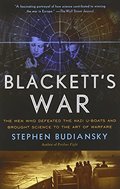 | by Stephen Budiansky
The Men Who Defeated the Nazi U-Boats and Brought Science to the Art of Warfare Warfare
2013, Vintage
ISBN 0307743632
Paperback, 348 pages
A Washington Post Notable BookIn March 1941, after a year of devastating U-boat attacks, the British War Cabinet turned to an intensely private, bohemian physicist named Patrick Blackett to turn the tide of the naval campaign. Though he is little remembered today, Blackett did as much as anyone to defeat Nazi Germany, by revolutionizing the Allied anti-submarine effort through the disciplined, systematic implementation of simple mathematics and probability theory. This is the story of how British and American civilian intellectuals helped change the nature of twentieth-century warfare, by convincing disbelieving military brass to trust the new field of operational research.Purchase information: (info)
 Get Blackett's War now at amazon.co.uk (£ 13.95) Get Blackett's War now at amazon.co.uk (£ 13.95) |
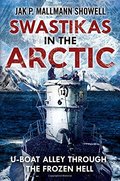 | by Jak P Mallmann Showell
U-boat Alley through the Frozen Hell
2014, Fonthill Media
ISBN 1781552924
Hardcover, 240 pages
During the Second World War, the Arctic saw an unusually high intensity of action, adventure, excitement and tragedy, and Swastikas in the Arctic: U-boat Alley Through the Frozen Hell describes the German military activities in that harsh frozen hell. Based mainly on original logs, the bare facts have been fleshed out with help from veterans and researchers from the United States, Iceland, Britain, Norway, Germany and Russia. This has made it possible to describe some of the now forgotten battles, the secret U-boat activities, the German struggle to broadcast essential weather data to Berlin and the incredible surface ship activity that forced Britain to launch major offensives against heavy odds. The Arctic also saw intense British efforts to help with the cracking of the highly complicated Enigma radio code. Many studies of the Second World War give scant attention to activity in this ice-studded ocean. However, as becomes apparent reading this book, those who fought, suffered and died there were shot at and bombed more heavily than in any other theater of war and the contribution they made influenced military actions far away in warmer regions. Gloriously illustrated with many unpublished photographs, Swastikas in the Arctic: U-boat Alley Through the Frozen Hell is a thrilling account of a war fought in very difficult circumstances.Purchase information: (info)
 Get Swastikas in the Arctic now at amazon.co.uk (£ 20.00) Get Swastikas in the Arctic now at amazon.co.uk (£ 20.00) |
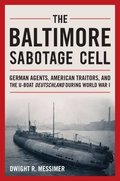 | by Dwight R. Messimer
German Agents, American Traitors, and the U-boat Deutschland During World War I
2015, Naval Institute Press
ISBN 1591141842
Hardcover, 280 pages
By the summer of 1915 Germany was faced with two major problems in fighting World War I: how to break the British blockade and how to stop or seriously disrupt the British supply line across the Atlantic. Th e solution to the former was to find a way over, through, or under it. Aircraft in those days were too primitive, too short range, and too underpowered to accomplish this, and Germany lacked the naval strength to force a passage through the blockade. But if Germany could build a fleet of cargo U-boats that were large enough to carry meaningful loads and had the range to make a round trip between Germany and the United States without refueling, the blockade might be successfully broken.Since the German navy could not cut Britain’s supply line to America, another answer lay in sabotaging munitions factories, depots, and ships, as well as infecting horses and mules at the western end of the supply line. German agents, with American sympathizers, successfully carried out more than fifty attacks involving fires and explosions and spread anthrax and glanders on the East Coast before America’s entry into the war on 6 April 1917.Breaking the blockade with a fleet of cargo U-boats provided the lowest risk of drawing America into the war; at the same time, sabotage was incompatible with Germany’s diplomatic goal of keeping the United States out of the war. The two solutions were very different, but the fact that both campaigns were run by intelligence agencies?the Etappendienst (navy) and the Geheimdienst (army), through the agency of one man, Paul Hilken, in one American city, Baltimore, make them inseparable. Those solutions created the dichotomy that produced the U-boat Deutschland and the Baltimore Sabotage Cell. Here, Messimer provides the first study of the degree to which U.S. citizens were enlisted in Germany’s sabotage operations and debunks many myths that surround the Deutschland.Purchase information: (info)
 Get The Baltimore Sabotage Cell now at amazon.co.uk (£ 30.50) Get The Baltimore Sabotage Cell now at amazon.co.uk (£ 30.50) |
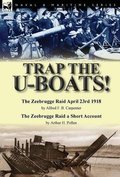 | by Alfred F. B. Carpenter
The Zeebrugge Raid April 23rd 1918 by Alfred F. B. Carpenter & The Zeebrugge Raid a Short Account by Arthur H. Pollen
2015, LEONAUR
ISBN 1782824677
Hardcover, 244 pages
A desperate raid to save the merchant ships that supplied the Allied cause From the first months of 1915, when the Great War on the Western Front ground to a stalemate of fixed lines of trenches, the protagonists were committed to a conflict of attrition. Neither side could affect a military breakthrough, but the Allies had the distinct advantages of both unrestricted access to the worlds seaways and the a steady stream of materiel which crossed the Atlantic from the United States of America. To disrupt this essential war traffic Germany fine tuned submarine warfare in the form of the U-Boat. This countermeasure proved so effective that the huge number of merchant vessels sunk by German submarines meant that by 1917 there was a realistic potential that the Allies might lose the war having been denied sufficient resources to continue to fight. To hinder the effectiveness of the U-Boat 'wolf-packs,' a daring raid was devised to blockade the principal submarine base at the port Zeebrugge in Belgium by sinking a vessel in the approaches to its harbour. This audacious action, carried out by the Royal Navy, became one of the most remarkable feats of naval warfare of the First World War. This Leonaur book contains two accounts of the Zeebrugge Raid and is recommended. Leonaur editions are newly typeset and are not facsimiles; each title is available in softcover and hardback with dustjacket; our hardbacks are cloth bound and feature gold foil lettering on their spines and fabric head and tail bands.Purchase information: (info)
 Get Trap the U-Boats! now at amazon.co.uk (£ 19.00) Get Trap the U-Boats! now at amazon.co.uk (£ 19.00) |
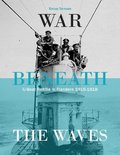 | by Tomas Termote
U-Boat Flotilla Flandern
2017, Uniform Press
ISBN 191050064X
Hardcover, 352 pages
Amid the stalemate of World War I, one area in which the German military could claim almost complete supremacy was beneath the ocean. In the four years of the war, the U-boats of U-Flottille Flanders alone would sink more than 2,500 Allied ships, sending more than 2.5 million tons of shipping to the bottom. But their victories came at a high cost: as the Royal Navy made taking out U-boats a priority, using mines, nets, aircraft, espionage, and more, and by the end of the war they had sunk eighty percent of the U-boats that operated out of Flemish ports. ?This book brings the secret of those sunken subs back to the surface. Underwater archaeologist and naval historian Tomas Termote draws on his countless visits to the wrecks of U-boats to explore topics ranging from their role in the war to the everyday lives of the men on board. Termote illustrates his account with copious underwater photography of the wrecks, and he uses that and new identifications to present the first ever complete account of the fate of every U-boat in the fleet, including boats sunk off the coasts of Great Britain, Belgium, Holland, France, Ireland, Spain, and the United States. The result is a book sure to grip any WWI buff, helping us understand with new clarity one of the crucial theaters of the war.Purchase information: (info)
 Get War Beneath the Waves now at amazon.com ($ 35.40) Get War Beneath the Waves now at amazon.com ($ 35.40)
 Get War Beneath the Waves now at amazon.co.uk (£ 30.00) Get War Beneath the Waves now at amazon.co.uk (£ 30.00) |
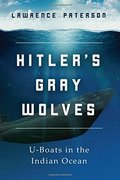 | by Lawrence Paterson
U-Boats in the Indian Ocean
2017, Carrel Books
ISBN 1510717765
Hardcover, 288 pages
Next to nothing has been written about the U-boat war in the Indian Ocean. This is the story of a forgotten campaign. The battle began in August 1943, when a German submarine arrived in the Malaysian harbor of Georgetown. In total, nearly forty U-boats were assigned to penetrate the Indian Ocean, serving alongside troops of the occupying Imperial Japanese forces. The Japanese allowed U-boats to use Malaysia as an operational station. From that base, they mixed with Japanese forces on a hitherto unseen scale: a move which spread the U-boat war throughout the vast Indian Ocean and into the Pacific. Success in this theater of war held a real chance to swing the tide of battle in North Africa in favor of Rommel, but the Germans essentially did too little too late. The joint action also gave U-boats the opportunity to penetrate the Pacific Ocean for the first time, attacking shipping off the Australian coast and hunting off New Zealand. Plans were even afoot for an assault on American supply lines. The cooperation' also brought into stark relief the fundamental differences of German and Japanese war aims. After the crews of Italian supply submarines joined the Germans and Japanese, relations between the fighting men of the three main Axis powers were often brutal and almost constantly turbulent. Stories of U-boats laden with gold and treasure stem almost exclusively from boats destined to and returning from Japanese-controlled Malaysia, laden with material exchanged between the two major partners of the Triple Axis Alliance.Purchase information: (info)
 Get Hitler's Gray Wolves now at amazon.com Get Hitler's Gray Wolves now at amazon.com
 Get Hitler's Gray Wolves now at amazon.co.uk Get Hitler's Gray Wolves now at amazon.co.uk |
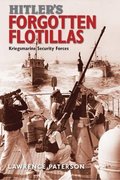 | by Lawrence Paterson
Kriegsmarine Security Forces
2017, Naval Institute Press
ISBN 1473882397
Hardcover, 336 pages
This study of the Kriegsmarine’s Sicherungsstreitkräfte, their security forces, fills a gap in the study of the German navy in World War II. This book describes the wide array of vessels including patrol boats, minesweepers, submarine hunters, barrage breakers, landing craft, minelayers, and even the riverine flotilla that patrolled the Danube as it snaked towards the Black Sea. These vessels may not have provided the glamour associated with capital ships and U-boats, but they were crucial to the survival of the Kriegsmarine at every stage of hostilities.As naval construction was unable to keep pace with the likely demand for security vessels, Grossadmiral Erich Raeder turned to the conversion of merchant vessels. For example, trawlers were requisitioned as patrol boats (Vorpostenboote) and minesweepers (Minensucher), while freighters, designated Sperrbrecher, were filled with buoyant materials and sent to clear minefields. Submarine hunters (U-Boot Jäger) were requisitioned fishing vessels. More than 120 flotillas operated in wildly different conditions, from the Arctic to the Mediterranean, and eighty-one men were to be awarded the Knight’s Cross; some were still operating after the cessation of hostilities clearing German minefields. Paterson documents organizational changes, describes the vessels, and recounts individual actions of ships at sea. Extensive appendices are included. Purchase information: (info)
 Get Hitler's Forgotten Flotillas now at amazon.co.uk (£ 25.00) Get Hitler's Forgotten Flotillas now at amazon.co.uk (£ 25.00) |
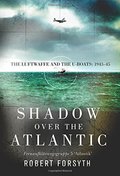 | by Robert Forsyth
The Luftwaffe and the U-boats: 1943–45
2017, Osprey Publishing
ISBN 1472820452
Hardcover, 312 pages
German U-boats were the scourge of Allied merchant and military shipping in the Atlantic during World War II, threatening to isolate and then starve the UK out of the war. As Germany's war against the Allied convoys intensified in late 1943, German Admiral Karl Dönitz called upon the Luftwaffe to provide a long-range spotting and shadowing unit to act as 'eyes' for his U-boats. Equipped with big, four-engined Junkers Ju 290s fitted out with advanced search radar and other maritime 'ELINT' (electronic intelligence) devices, Fernaufklärungsgruppe (FAGr) 5 'Atlantic' undertook a distant, isolated campaign far out into the Atlantic and thousands of miles away from its home base in western France. The information generated and reported back to Dönitz's headquarters was vital to the efforts of the U-boats, and FAGr 5's 'shadowing' missions were assigned priority in terms of skilled crews, supplies and equipment.This book tells for the first time the fascinating story of the formation and operations of FAGr 5 'Atlantik', drawing on never-before-published historical records of the unit that accounted for the reporting and destruction of thousands of tons of Allied shipping.Purchase information: (info)
 Get Shadow over the Atlantic now at amazon.co.uk (£ 20.00) Get Shadow over the Atlantic now at amazon.co.uk (£ 20.00) |
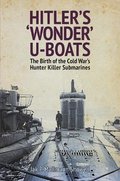 | by Jak P Mallmann Showell
The Birth of the Cold War's Hunter-Killer Submarines
2018, Naval Institute Press
ISBN 1526724804
Hardcover, 312 pages
Launched during the last days of the Third Reich in an attempt to restart the Battle of the Atlantic, the majority of these revolutionary Electro-U-boats never saw action. Instead, they became the forebears of the Cold War’s much dreaded hunter killer submarines.Slotted in among the highly technical information in the German U-boat Mussum were some fascinating personal logbook annotations from men who served in these boats. These non-technical, human anecdotes are now being transformed to form the core of this book.Rather than compiling a technical treatise, Hitler’s ‘Wonder’ U-boats makes maximum use of the personal accounts to tell the human story of how this new generation of submarines went to war under the incredibly harsh conditions that prevailed at the time.Accompanied by more than 100 images, this unique operational information will be mirrored with similar reports from conventional snorkel-fitted U-boats, which were at sea at about the same time, to provide a good comparison with earlier types. Thus, making it easy to appreciate the improvements that were made in such an incredibly short period of time to place the electro-U-boat among the great technical achievements of the 20th Century.Purchase information: (info)
 Get Hitler's 'Wonder' U-Boats now at amazon.co.uk (£ 25.00) Get Hitler's 'Wonder' U-Boats now at amazon.co.uk (£ 25.00) |
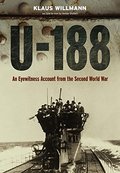 | by Klaus Willmann
A German Submariner’s Account of the War at Sea 1941-1945
2015, Frontline Books
ISBN 1848327609
Hardcover, 240 pages
Anton Staller was a U-boat lookout, rising no higher than Leading Seaman and his account of the war from the lower ranks is unique. He served on the Type IXc/40 boat, U-188 under Kapitänleutnant Lüdden on three patrols witnessing the stark reality of convoy warfare from his lookout position on the conning tower of his submarine. His U-boat sank the British destroyer HMS Beverley and eight merchant ships exceeding 100,000 gross tons but the submarine also spent many hours submerged under depth-charge attacks. More so than many of his contemporaries, Staller was prepared to reveal his thoughts and feelings of his experiences of the war at sea, and of his time on the conning tower, at the hydrophons, and cleaning weapons as a messboy.His journal demonstrates how political thinking rarely entered the minds of the U-boat men, even though many of them, such as Lüdden, did not choose to serve in submarines. Staller was not a Nazi and came from a Socialist Party background, yet he never questioned the cause he was fighting for. To Staller it was simply ‘Us or Them to the death’.Purchase information: (info)
 Get U-188 now at amazon.co.uk (£ 17.99) Get U-188 now at amazon.co.uk (£ 17.99) |
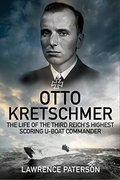 | by Lawrence Patterson
The Life of Germany's Highest Scoring U-boat Commander
2018, Naval Institute Press
ISBN 1784381926
Hardcover, 288 pages
Otto Kretschmer was only in combat from September 1939 until March 1941 but was Germany's highest-scoring U-boat commander sinking 47 ships totaling 274,333 tons. This definitive work details his personal story and the political backdrop from his earliest days.After completing his officer training and time on the training ship Niobe he served aboard the light cruiser Emden. In December 1934, he was transferred to the light cruiser Köln, then in January 1936 made the move to the fledgling U-boat service. His first operational posting was to the 2nd U-Flotilla’s Type VII U35 where he almost being drowned during training in the Baltic Sea. During the Spanish Civil War, Kretschmer was involved in several patrols as part of the international non-intervention force. He demonstrated a cool approach to combat: his mantra ‘one torpedo for one ship’ proved that the best way for his boat to succeed against a convoy was to remain surfaced as much as possible, penetrating the convoy and using the boat’s high speed and small silhouette to avoid retaliation. His nickname ‘Silent Otto’ referred to his ability to remain undetected and his reluctance to provide the regular radio reports required by Dönitz: he had guessed that the Allies had broken German codes. Alongside his military skill was a character that remained rooted in the traditions of the Prussian military.Purchase information: (info)
 Get Otto Kretschmer now at amazon.co.uk (£ 25.00) Get Otto Kretschmer now at amazon.co.uk (£ 25.00) |
 | by Geoffrey Bennett
2014, Pen and Sword
ISBN 1783462795
Paperback, 192 pages
The defeat that Rear-Admiral Sir Christopher Cradock suffered at Coronel in 1914 at the hands of Maximilian Graf von Spee, one of Germany’s most brilliant naval commanders, was the most humiliating blow to British naval prestige since the eighteenth century and a defeat that had to be avenged immediately. On 8 December 1914, the German squadron steamed towards Port Stanley, unaware that in the harbor lay two great British battle-cruisers, the ‘Invincible’ and ‘Inflexible’. Realizing this, Spee had no option but to turn and flee. Hour by hour during that long day, the British ships closed in until, eventually, Spee was forced to confront the enemy. With extraordinary courage, and against hopeless odds, the German cruisers fought to the bitter end. At five-thirty that afternoon, the last ship slowly turned and rolled to the bottom. Cradock and Britain had been avenged.Purchase information: (info)
 Get The Battles of Coronel and the Falklands, 1914 now at amazon.co.uk (£ 12.99) Get The Battles of Coronel and the Falklands, 1914 now at amazon.co.uk (£ 12.99) |
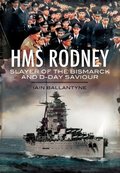 | by Iain Ballantyne
Slayer of the Bismarck and D-Day Saviour (Warships of the Royal Navy)
2012, Pen and Sword
ISBN 1848848706
Paperback, 320 pages
The Second World War battleship HMS Rodney achieved lasting fame for her role in destroying the pride of Hitler’s navy, the mighty Bismarck in a thrilling duel. The Rodney carrying the largest guns ever mounted in a British warship finally succeeded in turning her adversary into twisted metal and so removed a major threat to the Atlantic convoy routes so vital to the survival of the Nation and the war effort.This splendid book traces not only this mighty battleship’s career in detail but describes the careers of all the ships carrying the name.Purchase information: (info)
 Get HMS Rodney now at amazon.co.uk (£ 16.99) Get HMS Rodney now at amazon.co.uk (£ 16.99) |
 | by Erik Larson
The Last Crossing of the Lusitania
2015, Crown Publishers
ISBN 0307408868
Hardcover, 430 pages
#1 New York Times BestsellerFrom the bestselling author and master of narrative nonfiction comes the enthralling story of the sinking of the LusitaniaOn May 1, 1915, with WWI entering its tenth month, a luxury ocean liner as richly appointed as an English country house sailed out of New York, bound for Liverpool, carrying a record number of children and infants. The passengers were surprisingly at ease, even though Germany had declared the seas around Britain to be a war zone. For months, German U-boats had brought terror to the North Atlantic. But the Lusitania was one of the era’s great transatlantic “Greyhounds”—the fastest liner then in service—and her captain, William Thomas Turner, placed tremendous faith in the gentlemanly strictures of warfare that for a century had kept civilian ships safe from attack. Germany, however, was determined to change the rules of the game, and Walther Schwieger, the captain of Unterseeboot-20, was happy to oblige. Meanwhile, an ultra-secret British intelligence unit tracked Schwieger’s U-boat, but told no one. As U-20 and the Lusitania made their way toward Liverpool, an array of forces both grand and achingly small—hubris, a chance fog, a closely guarded secret, and more—all converged to produce one of the great disasters of history. It is a story that many of us think we know but don’t, and Erik Larson tells it thrillingly, switching between hunter and hunted while painting a larger portrait of America at the height of the Progressive Era. Full of glamour and suspense, Dead Wake brings to life a cast of evocative characters, from famed Boston bookseller Charles Lauriat to pioneering female architect Theodate Pope to President Woodrow Wilson, a man lost to grief, dreading the widening war but also captivated by the prospect of new love. Gripping and important, Dead Wake captures the sheer drama and emotional power of a disaster whose intimate details and true meaning have long been obscured by history.Purchase information: (info)
 Get Dead Wake now at amazon.co.uk Get Dead Wake now at amazon.co.uk |
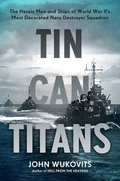 | by John Wukovits
The Heroic Men and Ships of World War II's Most Decorated Navy Destroyer Squadron
2017, Da Capo Press
ISBN 0306824302
Hardcover, 352 pages
An epic narrative of World War II naval action that brings to life the sailors and exploits of the war's most decorated destroyer squadronWhen Admiral William Halsey selected Destroyer Squadron 21 (Desron 21) to lead his victorious ships into Tokyo Bay to accept the Japanese surrender, it was the most battle-hardened US naval squadron of the war.But it was not the squadron of ships that had accumulated such an inspiring resume; it was the people serving aboard them. Sailors, not metallic superstructures and hulls, had won the battles and become the stuff of legend. Men like Commander Donald MacDonald, skipper of the USS O'Bannon, who became the most decorated naval officer of the Pacific war; Lieutenant Hugh Barr Miller, who survived his ship's sinking and waged a one-man battle against the enemy while stranded on a Japanese-occupied island; and Doctor Dow "Doc" Ransom, the beloved physician of the USS La Vallette, who combined a mixture of humor and medical expertise to treat his patients at sea, epitomize the sacrifices made by all the men and women of World War II.Through diaries, personal interviews with survivors, and letters written to and by the crews during the war, preeminent historian of the Pacific theater John Wukovits brings to life the human story of the squadron and its men who bested the Japanese in the Pacific and helped take the war to Tokyo.Purchase information: (info)
 Get Tin Can Titans now at amazon.com ($ 28.04) Get Tin Can Titans now at amazon.com ($ 28.04)
 Get Tin Can Titans now at amazon.co.uk Get Tin Can Titans now at amazon.co.uk |
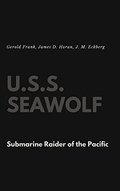 | by Gerold Frank
Submarine Raider of the Pacific
2017, Lulu.com
ISBN 138712109X
Hardcover, 146 pages
U.S.S. Seawolf: Submarine Raider of the Pacific is the famous first-hand account of the legendary U.S. Navy submarine Seawolf a.k.a. the Wolf which patrolled the Pacific during the conflict with Japan in World War 2. Shoving off the day of Pearl Harbor, Chief Radioman J. (Joseph) M. (Melvin) Eckberg gives the reader a tense and detailed account of his initial 24-month stint aboard the Seawolf and beyond.Purchase information: (info)
 Get U.S.S. Seawolf now at amazon.co.uk (£ 25.70) Get U.S.S. Seawolf now at amazon.co.uk (£ 25.70) |
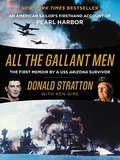 | by Donald Stratton
An American Sailor's Firsthand Account of Pearl Harbor
2016, William Morrow
ISBN 0062645358
Hardcover, 320 pages
THE FIRST MEMOIR BY A USS ARIZONA SURVIVOR: Donald Stratton, one of the battleship's five living heroes, delivers an "epic,"* "powerful,"** and "intimate"** eyewitness account of Pearl Harbor and his unforgettable return to the fight. A TOP-TEN NEW YORK TIMES BESTSELLER!At 8:06 a.m. on December 7, 1941, Seaman First Class Donald Stratton was consumed by an inferno. A million pounds of explosives had detonated beneath his battle station aboard the USS Arizona, barely fifteen minutes into Japan’s surprise attack on American forces at Pearl Harbor. Near death and burned across two thirds of his body, Don, a nineteen-year-old Nebraskan who had been steeled by the Great Depression and Dust Bowl, summoned the will to haul himself hand over hand across a rope tethered to a neighboring vessel. Forty-five feet below, the harbor’s flaming, oil-slick water boiled with enemy bullets; all around him the world tore itself apart. In this extraordinary never-before-told eyewitness account of the Pearl Harbor attack—the only memoir ever written by a survivor of the USS Arizona—ninety-four-year-old veteran Donald Stratton finally shares his unforgettable personal tale of bravery and survival on December 7, 1941, his harrowing recovery, and his inspiring determination to return to the fight. Don and four other sailors made it safely across the same line that morning, a small miracle on a day that claimed the lives of 1,177 of their Arizona shipmates—approximately half the American fatalaties at Pearl Harbor. Sent to military hospitals for a year, Don refused doctors’ advice to amputate his limbs and battled to relearn how to walk. The U.S. Navy gave him a medical discharge, believing he would never again be fit for service, but Don had unfinished business. In June 1944, he sailed back into the teeth of the Pacific War on a destroyer, destined for combat in the crucial battles of Leyte Gulf, Luzon, and Okinawa, thus earning the distinction of having been present for the opening shots and the final major battle of America’s Second World War.As the seventy-fifth anniversary of the Pearl Harbor attack approaches, Don, a great-grandfather of five and one of five living survivors of the Arizona, offers an unprecedentedly intimate reflection on the tragedy that drew America into the greatest armed conflict in history. All the Gallant Men is a book for the ages, one of the most remarkable—and remarkably inspiring—memoirs of any kind to appear in recent years.*New York Post**Library JournalPurchase information: (info)
 Get All the Gallant Men now at amazon.co.uk Get All the Gallant Men now at amazon.co.uk |
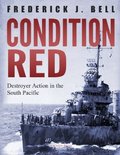 | by Frederick J. Bell
Destroyer Action in the South Pacific
2017, CreateSpace Independent Publishing Platform
ISBN 1976500214
Paperback, 130 pages
“Condition Red” was an expression that we used to indicate the imminence of any type of engagement. Aboard the G it was a colloquialism that served to express the conviction that the next few hours or days or weeks were going to be packed with action. We first heard it soon after we arrived in the Solomons, where the term was used on Guadalcanal and Tulagi to indicate the approach of the enemy, and when our voice radio blared out the words we went to General Quarters and prepared to greet the Tokyo Express or the Zeros and Mitsubishis when they came within view. Frederick J. BellPurchase information: (info)
 Get Condition Red now at amazon.com ($ 5.99) Get Condition Red now at amazon.com ($ 5.99) |
| | by McCartney, Innes
Comparing the Archaeology of German Submarine Wrecks to the Historical Text
2015, Routledge Taylor & Francis
ISBN 978-1-138814356
Hardcover, 328 pages, 119 figures
A major academic work which provides first-hand artefactual evidence of dives on over 40 WWI and WW2 U-Boat wrecks in the English Channel. The majority of wrecks are documented with underwater photographs of identification features, and a diagram of how the wreck lies, correlated to UK Hydrographic Survey position data. The wreck information is then correlated in a meticulous way with the historical record of Anti-Submarine Warfare ASW attacks to establish either firm or tentative identities of the wrecks. Of the 63 wreck sites in the study area, 41% were 'mystery sites' where the archaeology and documentary records did not match. Drawing on the work of Axel Niestle and others, Dr McCartney brings a new level of detail to what is known of the fates of individual U-Boats. He also puts forward larger conclusions regarding the Inshore Campaign of 1944-45 regarding the effectiveness of 'responsive minelaying' within UK territorial waters and the limitations of British Naval Intelligence in the closing months of WWII. The book is based on a PhD thesis following on from a systematic investigation of U-Boat wrecks from 1997 to 2013. One particularly poignant case study is that of U480, where a side-scan sonar trace shows clear details of the wreck of a previously-successful boat/crew which was sunk by a mine and lost with all hands with no witnesses. |
| | by Paul W Collins
St. John's, Newfoundland as a Case Stdy of SecondWorld War Allied Naval Base Development During the Battle of the Atlantic.
2014, WriteAdvice Press
ISBN 978-09878918-6-
Softcover
Explores the develpoment of St. John's, Newfoundland from merely a poorly defended harbour into on of the most important naval escort bases in the Northwest Atlantic. |
| | by James Goldrick
The Naval War in Northern European Waters, August 1914-February 1915
2015, Naval Institure Press
ISBN 9781591143499
Paperback, 382 pages, 11 maps
A balanced account of naval operations in the North Sea and the Baltic during the opening months of WWI |
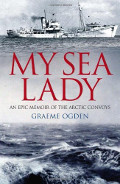 | by Graeme Ogden
An Epic Memoir of the Arctic Convoys
2014, Bene Factum Publishing
ISBN 1909657174
Paperback, 188 pages
A remarkable wartime memoir, unusually personal and frank, chronicling the bleak and arduous journeys onboard an anti-submarine trawler in the Arctic ocean during World War IIGraeme Ogden's memoir is the story of HMS Lady Madeleine, an ocean-going trawler converted to an antisubmarine role as part of the convoys to supply the Soviet Union as it faced the savage onslaught of the German army. This was a voyage fraught with storms, icebergs, and subzero temperatures in peacetime alone, but now the convoys faced worse—the fearsome gauntlet of German aircraft, submarines and surface raiders strung out along the coast of Norway, waiting to meet them. Ogden commanded the vessel in question, keeping diaries of his harrowing experiences of those years, which also cover his time on the equally perilous Atlantic convoys. These accounts were rediscovered and published as a memoir in the 1960s, illustrated with exquisite line drawings by Richard Elsden, who also sailed on these voyages. This is a very different kind of war memoir, vivid and bittersweet, in which the human elements take centerstage against the backdrop of great events.Purchase information: (info)
 Get My Sea Lady now at amazon.co.uk Get My Sea Lady now at amazon.co.uk |
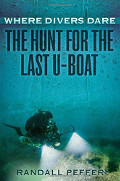 | by Randall Peffer
The Hunt for the Last U-Boat
2016, Dutton Caliber
ISBN 0425276368
Hardcover, 320 pages
In the tradition of Shadow Divers, this is the gripping true account of the search for German U-boat U-550, the last unfound, diveable wreck of a U-boat off the United States coast, and the battle in which it was sunk. On April 16, 1944, the SS Pan Pennsylvania was torpedoed and sunk by the German submarine U-550 off the coast of Nantucket, Massachusetts. In return the sub was driven to the surface with depth charges, and then sent to the bottom of the ocean by three destroyer escorts that were guarding the naval convoy. For more than sixty years the location of the U-boat’s wreck eluded divers. In 2012, a team found it—the last undiscovered U-boat in dive-able waters off the Eastern Seaboard of the United States, more than three hundred feet below the surface. This is the story of their twenty-year quest to find this "Holy Grail" of deep-sea diving and their tenacious efforts to dive on this treacherous wreck—and of the stunning clash at sea that sealed its doom and brought the Battle of the Atlantic to America’s doorstep.Purchase information: (info)
 Get Where Divers Dare now at amazon.com ($ 10.99) Get Where Divers Dare now at amazon.com ($ 10.99)
 Get Where Divers Dare now at amazon.co.uk (£ 23.99) Get Where Divers Dare now at amazon.co.uk (£ 23.99) |
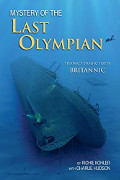 | by Richie Kohler
Titanic's Tragic Sister Britannic
2016, Best Publishing Company
ISBN 1930536860
Paperback, 228 pages
The book gives you a firsthand account as Richie Kohler (of Shadow Divers and Deep Sea Detectives) takes readers on the intriguing journey from the rise of the magnificent Olympians to the fateful day in 1916. He then moves forward in time through multiple expeditions beginning with the great Jacques Cousteau who located the ocean liner in 1975. Each successive team that risked their lives uncovered new clues, but it was not until 2009 when Richie and his dive partner definitively pinpointed the secret that had eluded them. Finally, in July 2015, Richie and a small team attained the goal of documenting their findings that answered the century-old question as to why all the engineering solutions built into the mighty Britannic could not save her from sharing the same fate as Titanic. Experience the expedition as Richie and his team unravel the mystery of the HMHS Britannic: With damage to only one compartment, the ship should have been able to stay afloat, and yet she sank twice as quickly as did Titanic. How was that possible? Was the hospital ship criminally torpedoed as the British press claimed, or did she ineptly blunder into a minefield, as the Bismarck Government countered? Violet Jessop survived the sinking of Britannic and Titanic. Experience her intriguing story.Purchase information: (info)
 Get Mystery of the Last Olympian now at amazon.co.uk (£ 19.99) Get Mystery of the Last Olympian now at amazon.co.uk (£ 19.99) |
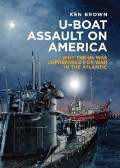 | by Ken Brown
The Eastern Seaboard Campaign 1942
2017, Naval Institute Press
ISBN 1473887283
Hardcover, 288 pages
The “Second Happy Time” was the informal name given to the phase of the battle of the Atlantic when German U-boats attacked both merchant and U.S. naval vessels along America’s east coast. With tankers burning and petrol rationing in New York City, the U.S. Navy seemed powerless to stop the deprivations of Hitler’s marauding U-boats.Ken Brown seeks to explain how the United States responded to these deadly assaults and looks at the steps that the Navy Department took to train the men, harness the scientists, and make the organizational changes that were required to defeat the German threat.Purchase information: (info)
 Get U-boat Assault on America now at amazon.co.uk (£ 22.50) Get U-boat Assault on America now at amazon.co.uk (£ 22.50) |
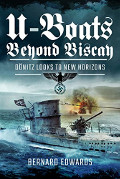 | by Bernard Edwards
Dönitz Looks to New Horizons
2017, Pen and Sword
ISBN 1473896053
Hardcover, 208 pages
On the outbreak of war in 1939 Admiral Donitzs U-boat flotillas consisted of some thirty U-boats fully operational, with only six to eight at sea at any one time. Their activities were restricted mainly to the North Sea and British coastal waters. When France fell in the summer of 1940, the ports in the Bay of Biscay gave direct access to the Atlantic, and the ability to extend their reach even to. The Royal Navy was unable to escort convoys much beyond the Western Approaches. In a short time, the Allies were losing 500,000 tons of shipping a month, every month. Donitz now looked over the far horizons, Americas Eastern Seaboard, the coasts of Africa, and the Mediterranean, where Allied merchantmen habitually sailed alone and unprotected. There was a rich harvest to be gathered in by the long range U-boats, the silent hunter-killers, mostly operating alone. This book tells their story.Purchase information: (info)
 Get U-Boats Beyond Biscay now at amazon.com ($ 13.84) Get U-Boats Beyond Biscay now at amazon.com ($ 13.84)
 Get U-Boats Beyond Biscay now at amazon.co.uk (£ 12.15) Get U-Boats Beyond Biscay now at amazon.co.uk (£ 12.15) |
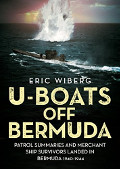 | by Eric Wiberg
Patrol Summaries and Merchant Ship Survivors Landed in Bermuda 1940-1944
2017, Fonthill Media
ISBN 1781556067
Hardcover, 256 pages
For the first time, a book exposes an obscure theater of the Second World War in great detail and comprehensively, not just in terms of geography but also from the perspectives of both Allied and Axis participants. U-Boats off Bermuda provides details of specific U-Boat patrols and their commanders, as well as a general overview of the situation in the theater of war around Bermuda. It is a detailed analysis of individual casualties, broken down by a) background of ship, b) background of U-boat, c) attack method (surface and/or submersed), d) details of survivors and their plight at sea and e) their rescue, recuperation and repatriation. Detailed maps and illustrations provide a human face to what were often tragic attacks with fatal consequences. Did you know that half a dozen German submarines came close enough to the Naval Operating Base in Bermuda to see Gibbs Hill? Or that hardy Canadians from a sunken trading schooner rowed and sailed their way to the remote island?on their own? Allied pilots based in Bermuda sank two German U-Boats, rescued dozens in daring water landings, and several crashed.Purchase information: (info)
 Get U-Boats off Bermuda now at amazon.com ($ 24.23) Get U-Boats off Bermuda now at amazon.com ($ 24.23)
 Get U-Boats off Bermuda now at amazon.co.uk (£ 25.00) Get U-Boats off Bermuda now at amazon.co.uk (£ 25.00) |
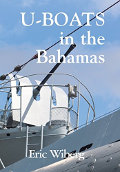 | by Eric Wiberg
2016, Brick Tower Press
ISBN 1899694625
Hardcover, 380 pages
[Eric Wiberg] ..".builds a character both attractive and intriguing to the reader. I ended genuinely curious about what might come next, and confident that I was in the hands of an expert story-teller." -William F. Buckley Jr. "Eric Wiberg's ability, to unearth obscure historical facts, keeps me in a constant state of surprise. I commend his relentless determination to verify every detail, with local sources in Nassau's historical community, for corroboration of his findings."-Capt. Paul C. Aranha, Author, The Island Airman . . . and his Bahama Islands Home. "Eric Wiberg has made a significant contribution to the bibliography of World War II history." -J. Revell Carr, Santa Fe, N.M. This book tells one more key part of the big story and is one more piece in the giant puzzle of the history of World War II. Its value for historians cannot be underestimated. Throughout the stories of the attacks by German and Italian submarines on Allied shipping in the water around the Bahamas and the Turks and Caicos, several consistent themes emerge in Wiberg's thorough accounts. Prime among them is the heroism of the merchant mariners who time and again put themselves in danger as they performed the critical task of moving supplies, military and civilian, which were vital to ultimate victory. We read of numerous instances of sailors having their ships shot out from under them and then continuously going back to sea and having additional ships torpedoed and sunk. We can also recognize what we know today as Post Traumatic Stress Disorder (PTSD), which was seldom recognized 75 years ago. Wiberg pays proper credit to the controversial Duchess of Windsor, whose husband was the wartime governor of the Bahamas. Just as she carried out this official duty, this book relates the heartening tales of everyday Bahamians, often poor and on outlying islands, who generously provided for these desperate castaways. Wiberg also acknowledges the heroism of the Axis submariners as he recounts not only their victories but also their deaths as many of the subs were eventually tracked down and sunk. History isn't great events, it is the continuum of many small events carried out by real people. U-Boats in the Bahamas and Turks and Caicos gives us an intimate glimpse of those events and, importantly, those people. J. Revell Carr Santa Fe, N.M.
Eric Wiberg grew up in the Bahamas, the son of the Swedish Consul-General there. A licensed maritime lawyer, his thesis for a Master's Degree in Marine Affairs was published as Tanker Disasters. For three years he commercially operated tankers in Singapore. Over 25 years he has sailed on 100 vessels, most of them sailboats, for 75,000 miles, including voyages across the Atlantic and Pacific and over 30 ocean passages to or from Bermuda. He has published four books, the latest being Round the World in the Wrong Season. A graduate of Boston College, he studied at Harris Manchester College, Oxford, and in Lisbon. Employed in the shipping industry in New York City, he lives with his wife and son in Westport, Connecticut. Purchase information: (info)
 Get U-Boats in the Bahamas now at amazon.com ($ 37.95) Get U-Boats in the Bahamas now at amazon.com ($ 37.95)
 Get U-Boats in the Bahamas now at amazon.co.uk (£ 35.95) Get U-Boats in the Bahamas now at amazon.co.uk (£ 35.95) |
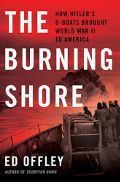 | by Ed Offley
How Hitler's U-Boats Brought World War II to America
2014, Basic Books
ISBN 0465029612
Kindle Edition, 320 pages
The untold story of two men—an American pilot and a German U-boat commander—whose clash off the coast of North Carolina brought the horrors of World War II to American shoresPurchase information: (info)
 Get The Burning Shore now at amazon.co.uk (£ 18.99) Get The Burning Shore now at amazon.co.uk (£ 18.99) |
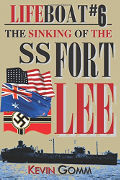 | by Kevin Gomm
The Sinking of the SS Fort Lee
2014, Digger Press
ISBN 0987223186
Paperback, 550 pages
Ever wanted to know what it is like to be on a torpedoed ship and then to spend the next several weeks in a lifeboat marooned at sea? On November 2, 1944 The U.S. oil tanker SS Fort Lee was torpedoed and sunk by the German U-boat submarine U-181 in the Indian Ocean. Four lifeboats managed to safely get away. What the men aboard these lifeboats endured next is their own odyssey - battling privations, storms, rough seas, despair, and clinging to hope that rescue will arrive. Together they all had one thing in common….they were survivors. Over 7 years of research have gone into the telling of this extraordinary story. The 550 page book includes 50 rare photographs including actual documents and letters from the survivors and their families. November 2, 2014 marks the 70th anniversary of this historic event. We observe, pause and remember. Purchase information: (info)
 Get Lifeboat #6 now at amazon.co.uk (£ 13.60) Get Lifeboat #6 now at amazon.co.uk (£ 13.60) |
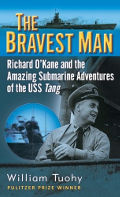 | by William Tuohy
Richard O'Kane and the Amazing Submarine Adventures of the USS Tang
2006, Presidio Press
ISBN 089141889X
Mass Market Paperback, 448 pages
“There’s no margin for mistakes in submarines. You’re either alive or dead.”–Richard O’KaneHailed as the ace of aces, captain Richard O’Kane, winner of the Congressional Medal of Honor for his consummate skill and heroism as a submarine skipper, sank more enemy ships and saved more downed fliers than anyone else.Now Pulitzer Prize—winning author William Tuohy captures all the danger, the terror, and the pulse-pounding action of undersea combat as he chronicles O’Kane’s wartime career–from his valiant service as executive officer under Wahoo skipper Dudley “Mush” Morton to his electrifying patrols as commander of the USS Tang and his incredible escape, with eight other survivors, after Tang was sunk by its own defective torpedo.Above all, The Bravest Man is the dramatic story of mavericks who broke the rules and set the pace to become a new breed of hunter/killer submariners who waged a unique brand of warfare. These undersea warriors would blaze their own path to victory–and transform the “Silent Service” into the deadliest fighting force in the Pacific.Purchase information: (info)
 Get The Bravest Man now at amazon.co.uk (£ 6.99) Get The Bravest Man now at amazon.co.uk (£ 6.99) |
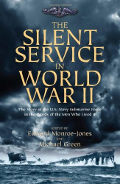 | by Michael Green
The Story of the U.S. Navy Submarine Force in the Words of the Men Who Lived It
2012, Casemate
ISBN 1612001254
Hardcover, 264 pages
When the Japanese attacked Pearl Harbor on 7 December 1941, the U.S. Navy had a total of 111 submarines. However, this fleet was not nearly as impressive as the number suggests. It was mostly a collection of aging boats from the late teens and early twenties, with only a few of the newer, more modern Gato-class boats. Fortunately, with the war in Europe was already two years old and friction with Japan ever-increasing, help from what would become known as the Silent Service in the Pacific was on the way: there were 73 of the new fleet submarines under construction. The Silent Service in World War II tells the story of America’s intrepid underwater warriors in the words of the men who lived the war in the Pacific against Japan. The enemy had already begun to deploy advanced boats, but the U.S. was soon able to match them. By 1943 the new Gato-class boats were making a difference, carrying the war not just to the Japanese Imperial Navy, but to the vital merchant fleet that carried the vast array of materiel needed to keep the land of the Rising Sun afloat. As the war progressed, American success in the Solomons, starting with Guadalcanal, began to constrict the Japanese sea lanes, and operating singly or in wolfpacks they were able to press their attacks on convoys operating beyond the range of our airpower, making daring forays even into the home waters of Japan itself in the quest for ever more elusive targets. Also taking on Japanese warships, as well as rescuing downed airmen (such as the grateful first President Bush), U.S. submarines made an enormous contribution to our war against Japan.This book takes you through the war as you learn what it was like to serve on submarines in combat, the exhilaration of a successful attack, and the terror of being depth-charged. And aside from enemy action, the sea itself could prove to be an extremely hostile environment as many of these stories attest. From early war patrols in obsolescent, unreliable S-boats to new, modern fleet submarines roving the Pacific, the forty-six stories in this anthology give you a full understanding of what it was like to be a U.S. Navy submariner in combat.REVIEWS “This is a compilation of many stories that originally appeared in the Polaris Magazine and is edited by Edward Monroe-Jones (A USSVI Life/Holland Club member and a member of the Bremerton Base) and Michael Green. Although you may have read these stories in the Polaris, it is worth the effort to read them again. I suspect that many of the AS readers and USSVI members have never read the Polaris so these are all new recollections. The book is designed for submariners and non-submariners alike as there is an excellent glossary at the beginning to define the abbreviations used. There are 46 separate “sea stories” that range from 1940 through 1945. It is an easy enjoyable read which I recommend.”American Submariner “..gives the reader a greater understanding of what it was like to be a U.S. Navy submariner in combat …the most comprehensive work ever assembled on World War II submarines then or since”Naval Historical Foundation enjoyable collection of good sea tales, with stories that intrigue and capture the imagination...The Northern Mariner …provides a colorful picture of the difficulties these crewmen encountered during the war…This eclectic collection of short reminiscences should help make the wartime experiences of those men available to a wider audience Journal of America's Military Past For this history collection, the first-person narratives of WWII veterans who served on S and fleet-type submarines are divided into three chronological sections....The book includes a glossary of technical terms and submariner slang, as well as background on the features of submarines and a run-down of common misconceptions about submarine life. The b&w historical photos come primarily from the Naval Historical Center and the National Archives, with a few from private collections. The book also includes a two-page b&w map of the Pacific.ProtoViewPurchase information: (info)
 Get The Silent Service in World War II now at amazon.co.uk (£ 25.00) Get The Silent Service in World War II now at amazon.co.uk (£ 25.00) |
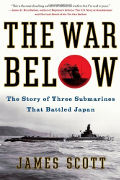 | by James Scott
The Story of Three Submarines That Battled Japan
2013, Simon & Schuster
ISBN 1439176833
Hardcover, 448 pages
THE WAR BELOW is the riveting story of the submarine force that helped win World War II in the Pacific by ravaging Japan’s merchant fleet and destroying the nation’s economy. Focusing on the unique stories of three of the war’s top submarines—Silversides, Drum, and Tang—James Scott takes readers beneath the waves to experience the determination, heroism, and tragedy that defined the submarine service. From the thrill of a torpedo hit on a loaded freighter to the terror of depth charge attacks that shattered gauges and sprang leaks, The War Below vividly re-creates the camaraderie, exhilaration, and fear of the brave volunteers who took the fight to the enemy’s coastline. Scott recounts incredible feats of courage—from an emergency appendectomy performed with kitchen utensils to the desperate struggle of sailors to escape from a flooded submarine trapped on the bottom—as well as moments of unimaginable tragedy, including an attack on an unmarked enemy freighter carrying 1,800 American prisoners of war. The casualty rate among submariners topped that of all other military branches. The war claimed almost one out of every five subs—and a submarine crewman was six times more likely to die than a sailor onboard a surface ship. But the submarine service accomplished its mission; Silversides, Drum, and Tang sank a combined sixty-two freighters, tankers, and transports. So ravaged from the loss of precious supplies due to the destruction of the nation’s merchant fleet were the Japanese that by the war’s end hungry civilians ate sawdust while warships lay at anchor due to lack of fuel and pilots resorted to suicidal kamikaze missions. In retaliation, the Japanese often beat, tortured, and starved captured submariners in the atrocious prisoner of war camps. Based on more than 100 interviews with submarine veterans and thousands of pages of previously unpublished letters and diaries, The War Below will let readers experience the battle for the Pacific as never before.Purchase information: (info)
 Get The War Below now at amazon.co.uk Get The War Below now at amazon.co.uk |
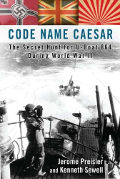 | by Jerome Preisler
The Secret Hunt for U-Boat 864 During World War II
2012, Berkley Caliber
ISBN 042524525X
Hardcover, 287 pages
As the Allies pressed forward both in Europe and the Pacific in the waning days of World War II, a little-known battle took place under the frozen seas off the coast of Norway…and changed the course of the war. By February of 1944, both Germany and Japan were falling back under constant attack from Allied forces. The end would have been inevitable, if not for a desperate, audacious plan by the German High Command. The Germans would pack a submarine—boat U-864—with their most advanced rocket and jet aircraft technology, a group of Japanese and German scientists, and tons of mercury for use in missile and torpedo detonation systems. With this, Japan could re-establish air superiority in the Pacific, forcing the Allies to divert troops and material long enough for Germany to re-group and prepare a final defense of the Fatherland. Unknown to them, British codebreakers, working hand-in-hand with the Norwegian underground, had discovered what the Axis powers were up to. Chasing U-864 and her cargo throughout the North Atlantic, the British bombed German naval bases and hidden installations in an attempt to destroy the submarine and her hidden cargo. But in the end, she was able to head out to sea and attempt to complete her mission. The British submarine HMS Venturer was waiting for her. In a cat-and-mouse silent battle beneath the waves, they hunted one another, each waiting to strike. The Venturer won the game, sinking U-864 and becoming the only submarine in history to sink another sub in underwater combat. This is the action-packed, dramatic account of one of the unsung greatest victories in military history, and of a historical moment in the annals of naval warfare. Purchase information: (info)
 Get Code Name Caesar now at amazon.co.uk Get Code Name Caesar now at amazon.co.uk |
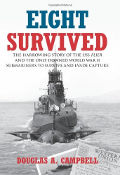 | by Douglas A. Campbell
The Harrowing Story of the USS Flier and the Only Downed World War II Submariners to Survive and Evade Capture
2010, Lyons Press
ISBN 1599219344
Hardcover, 304 pages
The incredible wartime saga of the only American submarinersto survive the sinking of their ship and evade enemy capture in WWII On the night of August 13, 1944, the U.S. submarine Flier struck a mine in the Sulu Sea in the southern Philippines as it steamed along the surface. All but fifteen of the more than eighty-strong crew went down with the vessel. Of those left floating in the dark, eight survived by swimming for seventeen hours before washing ashore on an uninhabited island. The story of the Flier and its eight survivors is wholly unique in the annals of U.S. military history. Eight Survived tells the gripping story of the doomed submarine and its crew from its first patrol, during which it sank several enemy ships, to the explosion in the Sulu Sea. Drawing on interviews with the survivors and on a visit to the jungle where they washed ashore—where a cast of fascinating characters helped the U.S. sailors evade the Japanese—Douglas Campbell fully captures the combination of extraordinary courage and luck that marked one of the most heroic episodes of World War II. Purchase information: (info)
 Get Eight Survived now at amazon.co.uk (£ 15.95) Get Eight Survived now at amazon.co.uk (£ 15.95) |
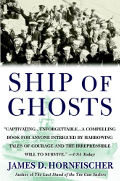 | by James D. Hornfischer
The Story of the USS Houston, FDR's Legendary Lost Cruiser, and the Epic Saga of her Survivors
2007, Bantam
ISBN 0553384503
Paperback, 544 pages
"Son, we’re going to Hell."The navigator of the USS Houston confided these prophetic words to a young officer as he and his captain charted a course into U.S. naval legend. Renowned as FDR’s favorite warship, the cruiser USS Houston was a prize target trapped in the far Pacific after Pearl Harbor. Without hope of reinforcement, her crew faced a superior Japanese force ruthlessly committed to total conquest. It wasn’t a fair fight, but the men of the Houston would wage it to the death.Hornfischer brings to life the awesome terror of nighttime naval battles that turned decks into strobe-lit slaughterhouses, the deadly rain of fire from Japanese bombers, and the almost superhuman effort of the crew as they miraculously escaped disaster again and again–until their luck ran out during a daring action in Sunda Strait. There, hopelessly outnumbered, the Houston was finally sunk and its survivors taken prisoner. For more than three years their fate would be a mystery to families waiting at home.In the brutal privation of jungle POW camps dubiously immortalized in such films as The Bridge on the River Kwai, the war continued for the men of the Houston—a life-and-death struggle to survive forced labor, starvation, disease, and psychological torture. Here is the gritty, unvarnished story of the infamous Burma–Thailand Death Railway glamorized by Hollywood, but which in reality mercilessly reduced men to little more than animals, who fought back against their dehumanization with dignity, ingenuity, sabotage, will–power—and the undying faith that their country would prevail.Using journals and letters, rare historical documents, including testimony from postwar Japanese war crimes tribunals, and the eyewitness accounts of Houston’s survivors, James Hornfischer has crafted an account of human valor so riveting and awe-inspiring, it’s easy to forget that every single word is true.From the Hardcover edition.Purchase information: (info)
 Get Ship of Ghosts now at amazon.com ($ 13.49) Get Ship of Ghosts now at amazon.com ($ 13.49) |
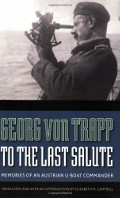 | by Von Trapp, Georg
2007, University of Nebraska Press
Paperback, 192 pages, 34 illustations
Georg Von Trapps enthralling account of his service as a U-Boat commander in WW1, translated by his granddaughter Elizabeth Campbell.Purchase information: (info)
 Get To the Last Salute: Memories of an Austrian U-Boat Commander now at amazon.co.uk Get To the Last Salute: Memories of an Austrian U-Boat Commander now at amazon.co.uk |
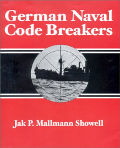 | by Jak P Mallmann Showell
2003, Ian Allan
ISBN 159114308X
160 pages
Though not strictly U Boat, it does cover a fascinating side of WW2 radio intelligence at sea but from the German side. Makes a change from Bletchley Park.Purchase information: (info)
 Get German Naval Code Breakers now at amazon.co.uk Get German Naval Code Breakers now at amazon.co.uk |
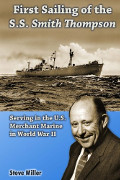 | by Miller, Steve
Serving in the U.S. Merchant Marine in World War II
2011, Merriam Press
ISBN 1468106422
Softcover, 242pp, 22 photos/charts
This the story of Lt(jg) Al Miller, USMS, a Communications Officer, and his first voyage of WW II aboard the brand new Liberty ship, S.S.Smith Thompson. Via a typed, secret journal kept by Lt(jg) Miller, we see typical life aboard a WW II merchantman. Miller held an FCC 1st class radio license for 20+ years when the U.S. entered the war; having learned the skill via U.S.Navy service at age 17, 1916-20. This is a special glimpse by a mature family man who chronicled things likely to have gone unnoticed by a man 20 years younger.Purchase information: (info)
 Get First Sailing of the S.S. Smith Thompson now at amazon.co.uk (£ 9.60) Get First Sailing of the S.S. Smith Thompson now at amazon.co.uk (£ 9.60) |
| | by Willigenburg, Henk
2010, Lanasta publishing
ISBN 9086160816
hardcover, a bout 300 + pages
pictures and drawings of all dutch nanaval warships in world war two |
|